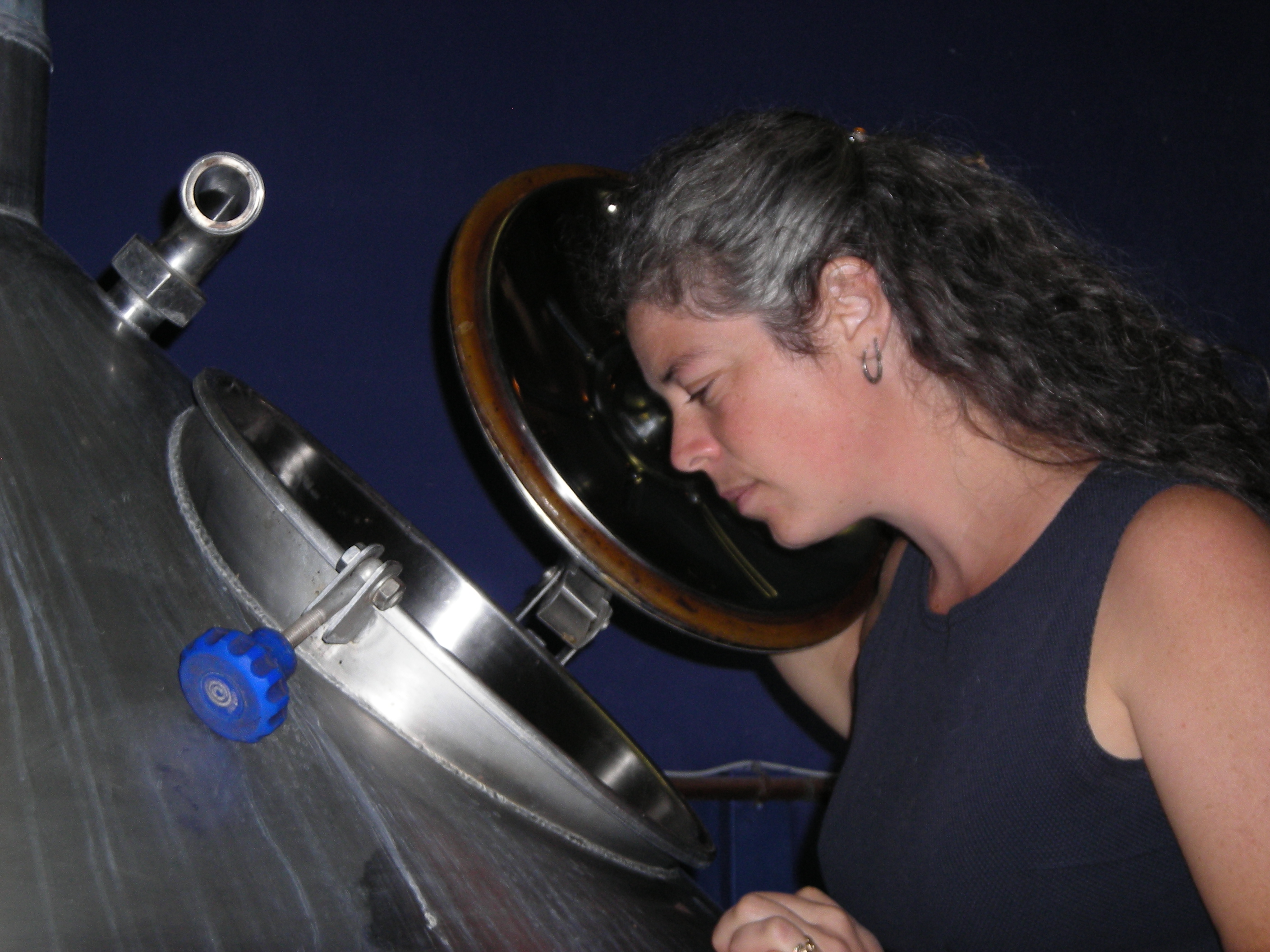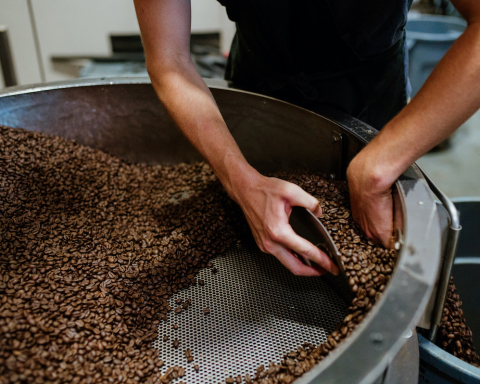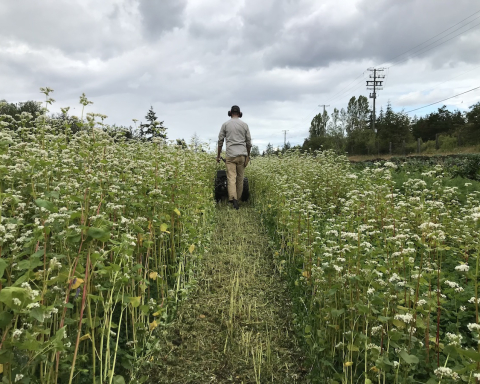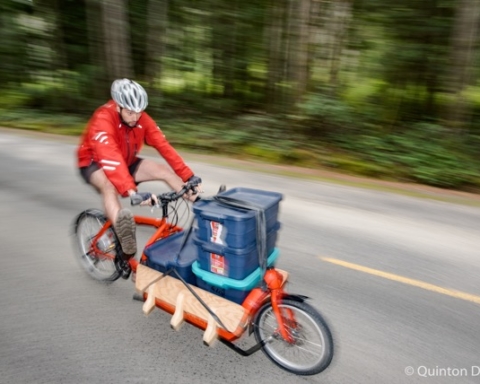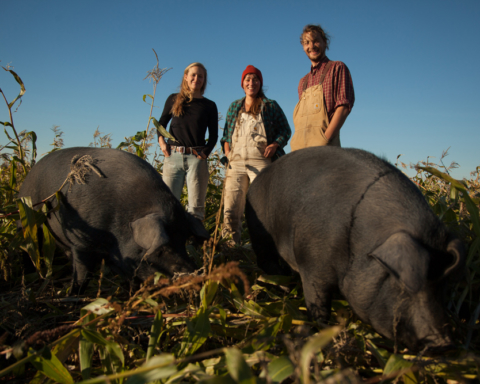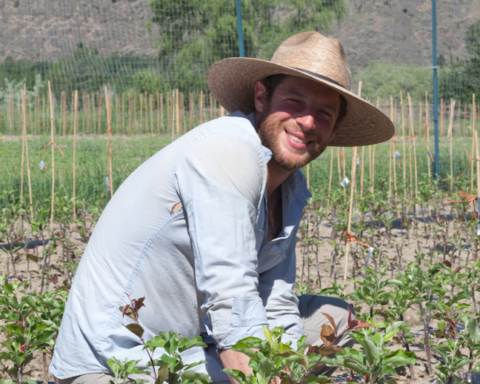Feature photo: No loose hair in a food processing environment unless it’s a photo shoot! Rebecca Kneen at Crannog Ales
Rebecca Kneen
Cleanup. We do it every day, in our homes and on our farms and in our food processing. For some of us, cleaning and sanitizing takes up more time than actually making or growing. For many farmers, though, cleaning is very much secondary to our primary goal of growing great food. Sure, we’ll spray out our picking baskets with water after digging potatoes in the rain, and we’ll make sure our salad spinner is free of chunks of clay and dried plants, but how much further do we need to go? And do we need to worry about sanitation at all?
Our regional Health Departments tend to prefer every food surface be disinfected, not just cleaned and sanitized, but few of us would adopt this either in principle or in practice. Fortunately, there’s a middle ground. I shall insert here a caveat for all readers: I am NOT a food safety expert. I am a Certification Committee member for NOOA and a brewer and farmer. This article is not the final word, but will hopefully be a useful basic guide.
First, it is necessary to differentiate between cleaners and sanitizers. Cleaners remove dirt, organic material, and some germs (bacteria, viruses, and fungi) by physically washing them away. They do not kill. Sanitizers are chemicals that actually kill bacteria, viruses, and fungi. Disinfectants kill more than sanitizers, but are not always necessary. A surface that is not already clean cannot be sanitized, no matter how hard you try. Cleaners and sanitizers must come in contact with 100% of the surfaces, including valves, corners, and other “blind” areas. And yes, more time and the correct temperature will increase effectiveness, while increased concentration can actually impede the usefulness of any given chemical.
The main principles of any cleaning and sanitizing regime are correct chemical & concentration, complete coverage, and sufficient time and temperature.
For most daily low-risk food applications, proper cleaning is all that is required. If a food is likely to be directly ingested after harvest (as with herbs, microgreens, or sprouts) without the consumer washing them, handling surfaces must also be sanitized, as water- or soil-borne bacteria can relatively easily remain on the food.
Our first approach, of course, is to use only water that is potable and to test regularly. City water is tested daily, but on-farm water sources should be tested annually or, for microgreens and sprouts, at least semi-annually. Water must be tested at the point of use—not at the wellhead, but at the tap in your washing station.
A wide variety of cleaners are usable in the organic standard, and most detergents are up to normal farm cleaning needs. However, reading the consumer label is not enough. Labels such as “biodegradable”, “natural”, or “non-toxic” are essentially meaningless and unregulated. Therefore it is important to not just read the label for active ingredients, but to get an MSDS sheet for the cleaning product and find out what else is in it, as carriers and surfactants can be on the prohibited list. This may require a direct request to the manufacturer and some effort to discover, but it will prevent you from having your certification removed.
Food processing, abattoirs, and sprout/microgreen production all require a bit more by way of cleaners and sanitizers. Dairies, slaughterhouses, and breweries face challenges in cleaning fats and proteins, and require both caustic and acid cleaning. Surfaces should be designed for easy cleaning and resistance to the chemicals needed, while appropriate chemicals to clean the particular type of soil must be sourced. In other words, know both your chemical and what you are trying to remove.
Sanitizers can be used to prevent or manage fungal diseases like damping off in greenhouses, or for tools being used for pruning in orchards, hopyards, or berry plantations. Different uses and different surfaces require different approaches, as with cleaning. Some sanitizers require a post-usage rinse with potable water, while others are “leave-on”. Soak or contact time is critical with sanitizers in particular, as there’s no easy “look test” to see if the sanitizer has done its job. Standard operating procedures help everyone maintain those critical thresholds.
Many producers rely on common household bleach for basic sanitation. Chlorine bleach is listed on the PSL, but beware: many bleach formulations include fragrances that are not allowed. Be very careful about dilution, and ensure the correct ratios are observed. Peroxyacetic Acid (hydrogen peroxide and acetic acid blend) is widely used as a substitute, and is considerably less toxic. It breaks down quickly into a mildly acidic water, which is great for your waste stream, and which is easy on the humans using it. Both bleach dilutions and peroxyacetic acid break down, which means that your mixes must be refreshed or replaced rapidly. Peroxyacetic acid is also a no-rinse sanitizer, which makes it easier to use.
Daily Operations Made Simple
The basic principle here is that if something is not straightforward, it will be done incorrectly. Clear, well-written, and organized procedures with tools directly at hand will ensure that everyone does the job right and rapidly every time.
First, think about what you are cleaning: are you simply doing an annual clean of your start trays? Are you cleaning your daily work surfaces? What are they made of, and what are you trying to remove? What are the potential bacteria, viruses or fungi you are trying to get rid of?
Do your homework: Research your chemicals and make sure everything you need and want to use will be allowed. Do this before the next certification application, so you aren’t caught out in non-compliance in the middle of operations. Get MSDS sheets, write to the manufacturers, and spend some quality time with the PSL. Trust me, it’s riveting.
Look over your equipment: what can you remove and soak in cleaner and sanitizer easily and safely? What needs to be cleaned in place (CIP)? Do you have the appropriate pumps, spray balls etc to run a CIP system? Will it reach all the blind areas? Do you have more than one cleaner type to make sure you can clean the different types of gunk?
Set up your tools: Set up spray bottles, measuring tools and mix buckets for both cleaners and sanitizers. Label each of them with the target dilution (especially spray bottles) and have recipes posted where chemicals are stored. All your chemicals should be in safe, secure storage where they are easily accessed by adults but not children and where you can also keep your measuring tools, but also where there is no chance of contaminating your food or ingredients if you spill.
Write it down: Follow yourself around for a day or a week, and observe what your regular processes are. How often do you need to clean and sanitize? Are you doing it? Are you not doing it because you don’t have the right hose nozzle, or someone keeps borrowing the scrub brush? Is your sanitizer spray bottle too far away or in a spot that’s too hard to reach? Is it a huge chore to set up your CIP system for one piece of machinery? Once you see what you are actually doing, you can see why you are not doing certain procedures—and then you can create a setup or a system that will make it easy to improve.
From that experience, you can create a Standard Operating Procedure, a routine that enables every person to do the same procedure reliably. It includes when to clean and sanitize every piece of equipment or surface, what the appropriate concentrations of chemicals are for different uses, and how frequently to replace chemical mixes. Daily checklists can be incorporated into your batch records or cleaning logs can simply be posted in the work area. Initialing tasks as completed is vital, especially for things like knowing who restocked the sanitizer spray bottle and when, as a missed day can mean no effective sanitizer was applied.
We check on our SOPs periodically, to make sure that they are working for everyone—sometimes you discover that a tool is missing, or a new employee can’t actually reach everything, or that interesting substitutions have been made. Even when you discover problems, they can teach you to change procedures, chemicals, or training. We have also discovered that all staff have to be trained to understand why the SOP is set up the way it is—why certain tanks have to be cleaned differently from other tanks, why contact times are important for sanitizers, and so on. For committed and interested staff, understanding the why will not just improve compliance but can improve the entire system.
Some Common Chemicals and their Effects
Ammonia and bleach (sodium hypochlorite) causes asthma in workers who breathe too much of it in their jobs. They can trigger asthma attacks in children or ECE providers who already have asthma. They can also irritate the skin, eyes, and respiratory tract.
Quaternary ammonium compounds (also known as QUATs, QACs, or QATs) are not volatile compounds, but using them as sprays can cause nose and throat irritation. Benzalkonium chloride is a severe eye irritant and causes and triggers asthma. Exposures to QUATs may cause allergic skin reactions. Use of QUATs has been associated with the growth of bacteria that are resistant to disinfection. Sometimes this resistance also transfers to antibiotics. In laboratory studies, QUATs were found to damage genetic material (genes).
Terpenes are chemicals found in pine, lemon, and orange oils that are used in many cleaning and disinfecting products as well as in fragrances. Terpenes react with ozone, especially on hot smoggy days, forming very small particles like those found in smog and haze that can irritate the lungs and may cause other health problems and formaldehyde which causes cancer, is a sensitizer that is linked to asthma and allergic reactions, has damaged genes in lab tests, is a central nervous system depressant (slows down brain activity), may cause joint pain, depression, headaches, chest pains, ear infections, chronic fatigue, dizziness, and loss of sleep.
Triclosan is a suspected endocrine disruptor and may lead to the development of antibiotic-resistant bacteria.
Phthalates are used in fragrances that are found in air fresheners and cleaning and sanitizing products. They are endocrine disruptors. Research indicates that phthalates increase the risk of allergies and asthma and can affect children’s neurodevelopment and thyroid function. Studies show links between phthalates in mothers to abnormal genital development in boys. Phthalates have been found in human urine, blood, semen, amniotic fluid, and breast milk.
Volatile organic compounds (VOCs) are chemicals that vaporize at room temperature. Many VOCs that are released by cleaning supplies have been linked to chronic respiratory problems such as asthma, allergic reactions, and headaches.
Environmentally friendly cleaners and sanitizers (not the same as organic!)
EcoLogo is a program of Underwriters Laboratory based in Canada. Some of these products are available in the U.S. and some are not. A list of certified cleaning products is available at ecologo.org/en/certifiedgreenproducts.
Green Seal is a program based in the U.S. And used by many institutional purchasers. A list of Certified Cleaning Products is available at greenseal.org/FindGreenSealProductsandServices.
Design for the Environment (DfE) is a U.S. EPA program. DfE certifies both institutional and retail/consumer products. A list of DfE-certified cleaning and other products are available at www.epa.gov/dfe/products.
Rebecca Kneen farms and brews with her partner Brian MacIsaac at Crannóg Ales, Canada’s first certified organic, on-farm microbrewery. They have been certified organic since inception in 1999. Their farm is a 10 acre mixed farm growing hops, fruit, and vegetables as well as pigs, sheep, and chickens. Rebecca has been involved in agriculture, food, and social justice issues since she met her first pair of rubber boots at age three on the family’s Nova Scotia farm.


